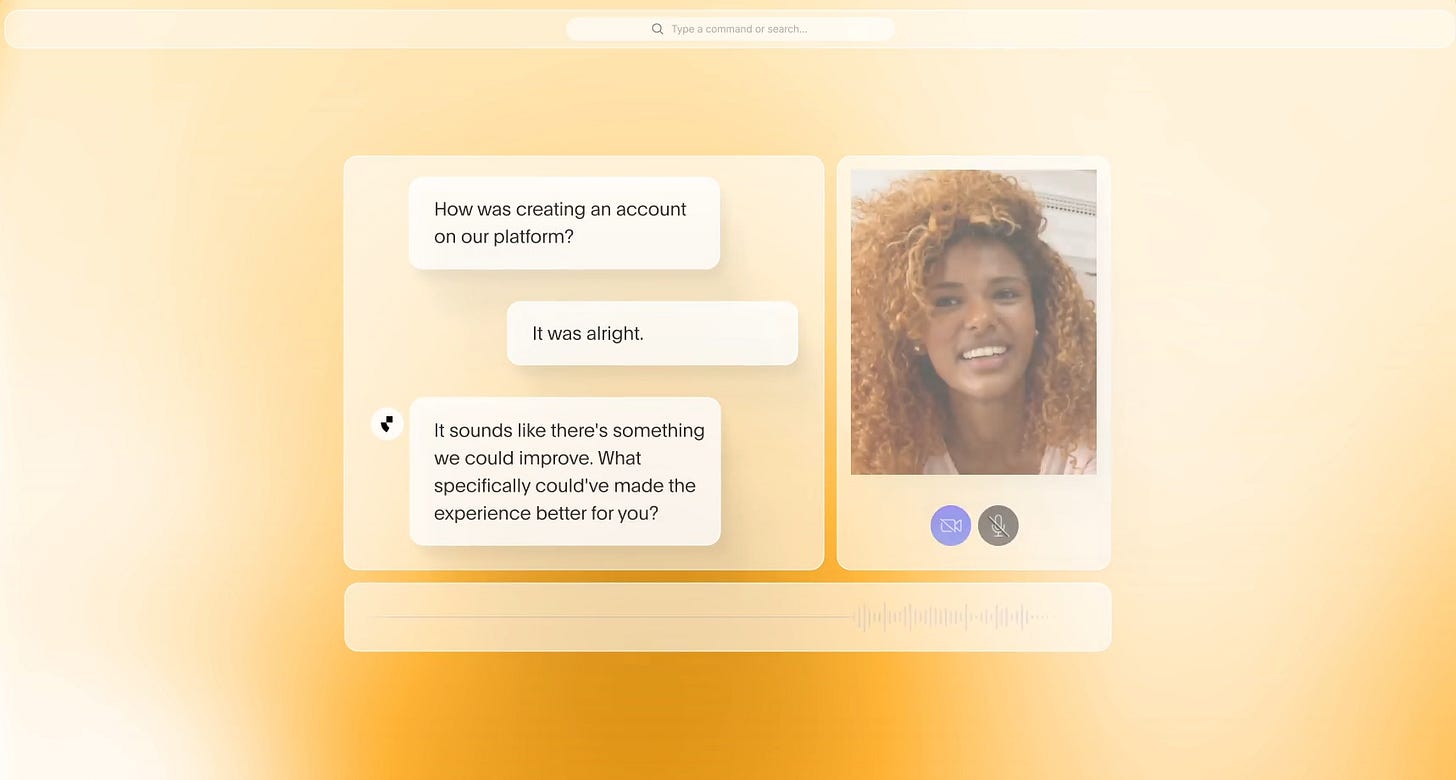Synthetic Populations
How AI Simulates Populations and Predicts Behavior
Weekly writing about how technology and people intersect. By day, I’m building Daybreak to partner with early-stage founders. By night, I’m writing Digital Native about market trends and startup opportunities.
If you haven’t subscribed, join 70,000+ weekly readers by subscribing here:
Synthetic Populations
One of my earliest jobs was walking door to door and asking people about paint.
Back in middle school, my friend Danielle and I were tasked with door-knocking and asking people (1) if they’d like to get their house painted, and (2) which shades in a selection of paint colors were their favorites. We were compensated based partly on how many new customers we drummed up, and partly based on how much market research we gathered on color preferences.
It was pretty mind-numbing work, but I learned a lot—mainly that a lot of Arizonans love a good coffee-colored home.
Today, this same job might be accomplished with an AI simulation. This is one of the more interesting trends in early-stage venture: synthetic populations.
Synthetic populations essentially means using AI to simulate human behavior. Digital Native is all about how technology and human behavior intersect, so naturally this topic fascinates me. Our piece this week is a quick summary of what we’re seeing in the market, then a quick examination of how synthetic populations might evolve from here.
Say that you’re McDonald’s and you want to understand how Trump’s tariffs will impact buying habits for lower-income Americans. In the past, you might spin up a real-world survey: someone, probably from a third-party survey provider, would walk around and poll people about their expected behaviors, much like me going door-to-door badgering people about different shades of brown. Naturally, this whole process is expensive and time-consuming.
Today, we (McDonald’s corporate) can use AI to simulate how people might behave.
How does this work in practice?
1) First, companies build a base synthetic population—a digital census of sorts.
This means starting with a statistically accurate population that mirrors the real world. Data sources here might include U.S. Census data, labor statistics, health records, and geospatial and mobility data. These inputs feed into the model, which generates agents—synthetic individuals with attributes like age, income, education, household size, and so on. This is like a digital twin of our society.
2) We then layer on behavior models.
Now it’s time to simulate what people do. It turns out humans behave in predictable patterns, and we leave behind a lot of data about our behaviors. We might look at historical behavior data here, layering in behavioral science and psychology frameworks (what people tend to do), then adding machine learning predictions (what people might do next). Data inputs can include everything from purchasing decisions to commuting patterns to media consumption habits.
3) We then calibrate with real data.
In this step, we tune those synthetic populations to reality—again and again and again. Models ingest real-world observational data—say, point of sale data—and use probabilistic modeling to constantly adjust behavior rules over time.
Use Cases
So what are the use cases here? You can imagine a wide array of ways that people can use population simulations. A few quick examples:
Corporate Strategy and Consumer Behavior
This is the McDonald’s example above, and there are plenty of adjacent possible use cases. Maybe Burger King wants to understand how a sugar tax will affect purchase behaviors among Hispanic customers. Maybe Wendy’s wants to understand how a new marketing campaign will impact sales of chocolate Frosty’s for women. And so on.
In the not-so-distant future, it might be anathema for a company to make a big decision without first consulting a simulation. One of the leading startups in the synthetic population space, Aaru, has leaned early into corporate strategy and consumer behavior.
Policies
We’ll see governments use synthetic populations to simulate policy proposals. Maybe Governor Hochul wants to better understand how congestion pricing will impact small businesses in lower Manhattan. Replica, a spinout of Sidewalk Labs, has pioneered in this space a bit: cities can use synthetic models to simulate traffic, housing, and so on.
Healthcare
Healthcare is an obvious one. How will populations respond to a pandemic? How will misinformation change health decisions? How will shifts in coverage influence health outcomes? You can imagine how helpful simulations would have been going into COVID, on everything from mask-wearing to vaccine rollout.
Insurance, Finance, and Housing
Insurance is all about predicting outcomes. Finance and housing are related industries. Examples here:
How will a 1% increase in unemployment change credit card debt for Gen Zs?
How will a new government policy on student loans change homeownership rates among Millennials?
How will a change in climate change insurance coverage for Los Angeles influence where people choose to live?
Media
Sinners surprised everyone—well, most people—by becoming a box office juggernaut. Less than a month after release, it already ranks as the 4th-highest-grossing horror film of all time. But maybe Sinners wouldn’t have been such a surprise if studios could more effectively simulate audience behavior.
You can easily see the use case here. How will a documentary about Roe v. Wade play with female Netflix viewers ages 18 to 35? Should the marketing campaign for the new Pixar movie focus on moms or dads? Does everyone hate Nicholas Cage, or does it just seem like that?
If you’re in Hollywood, get ready for a lot of simulations. I wish this data would become public: I’d love to pore over audience preferences and behaviors.
Another leading company in this space is Viewpoints. The two early use cases: product design and jury simulation. On the former, a company might use Viewpoints for market research—should we go with the more floral wine bottle, or the more traditional bottle? How will each bottle play with “occasional” drinkers vs. heavy drinkers?
Jury selection, meanwhile, is a key component of any case. Lawyers need to understand how different demographics, backgrounds, and belief systems could influence jury decisions.
How can these simulations be accurate, you might ask? Surely they can’t be as good as talking to real humans. The answer: they’re pretty close, and rapidly improving.
The founder of Viewpoints, Leo Yeykelis, actually co-authored a paper with Stanford and BU faculty last year, titled: “Using Large Language Models to Create AI Personas for Replication, Generalization and Prediction of Media Effects.” From the abstract:
The AI personas, 19,447 in total across all of the studies, generated complete datasets and statistical analyses were then compared with the original human study results. The LLM replications successfully reproduced 76% of the original main effects, demonstrating strong potential for AI-assisted replication.
AI is improving rapidly, and our population simulation models are improving in tandem. We’re getting pretty damn good at using technology to predict human behavior.
Two Related Topics: Digital Twins & AI Interviews
I want to briefly touch on two equally-interesting areas, both tangential to synthetic populations.
We’ve written in the past about digital twins. Digital twins actually first emerged in manufacturing. For instance, you can use a digital twin of a wind turbine to test stress under wind conditions, you can use a digital twin of a city to simulate traffic flows, and so on.
Now, of course, we have digital twins of real-life people. For last year’s The Evolution of the Creator, I built my own twin using Delphi, a company that lets you clone yourself. The tagline on the website: “Build the digital version of you to scale your expertise and availability, infinitely.” I let Delphi ingest my past writing, podcasts, and interviews to build a smart AI that can…well, talk like me. You can chat with my Delphi here:
Delphi starts with suggested questions. This is smart product design; talking to a clone is a new behavior, so we need some nudges in the right direction. (Egg Theory, anyone?) And my Delphi clone is surprisingly good at answering things the way I probably would.
Late last year, Masterclass introduced AI Mentors. Subscribers could chat with an AI Mark Cuban, for instance.
Digital twins are only going to get more popular. People want to talk with creators, celebrities, role models; the limiting factor is time (and time = money). I expect most “public figures” to have some version of a digital twin in a few years’ time.
Turning to the second topic: AI interviews.
Earlier, we mentioned companies like Aaru or Viewpoints that are helping customers effectively interview AIs. AI was the respondent. We’re seeing AI become the interviewer too.
One example is Listen Labs. Customers like Microsoft, SKIMS, and Canva use Listen for market research at scale. An AI interviewer probes participants for feedback, then summarizes key findings. A company can conduct a massive market research project in a matter of days.
Final Thoughts: Goodbye Gallup?
If you know anything about me after five years of Digital Native, it’s that I love some good data analysis. These often come in the form surveys, displayed in chart form: we’ve now seven (!) editions of the 10 Charts series. A common data source for those charts is Gallup.
Here’s one excerpt from an old Digital Native piece, and the chart that went alongside it:
A new survey from Gallup found that 22% of American workers now fear AI could replace them, up from 15% in 2021. AI fears among workers without college degrees remain consistent at ~20%, while AI fears among workers with college degrees went up dramatically—from 8% to 20% in two years.
It’s ironic that the poll covered technology taking over, because technology is now taking over both sides of the polling world.
On the respondent side, we’re swapping real-life humans (slow! expensive!) for AI simulations. On the interviewer side, we’re turning to companies like Listen Labs for AI interviewing. The economics are a lot better; the speed is hard to beat. But if you’re Gallup, you’re probably standing there wondering what just happened.
In April, we wrote about AIs that will do our work (The Third Workforce: Agentic Labor) and AIs that will be our friends (AI Friends Are a Good Things, Actually). But what about the AIs that will mimic us? That’s another big category, and we’re about to be swimming in facsimiles and simulations.
Thanks for reading! Subscribe here to receive Digital Native in your inbox each week:















